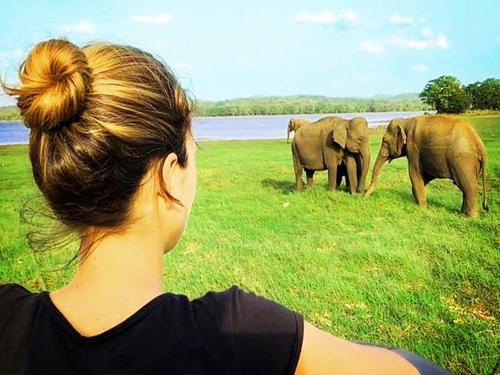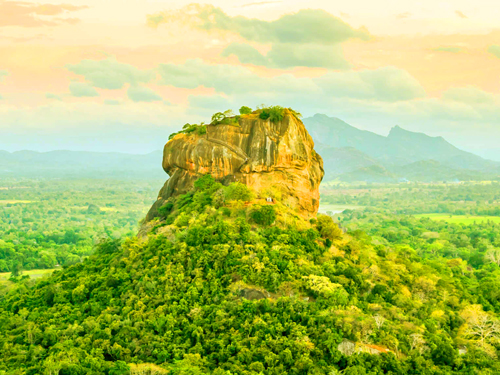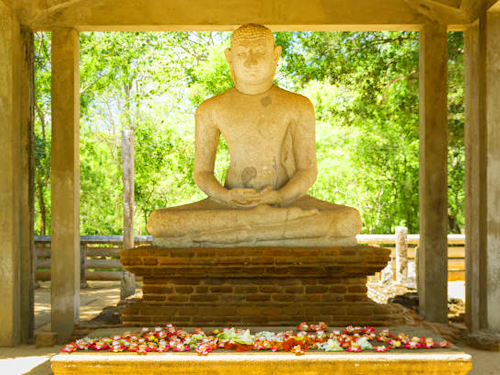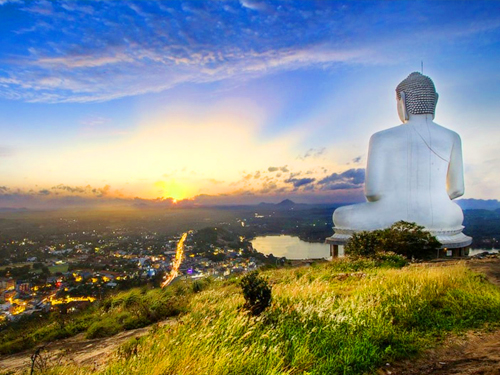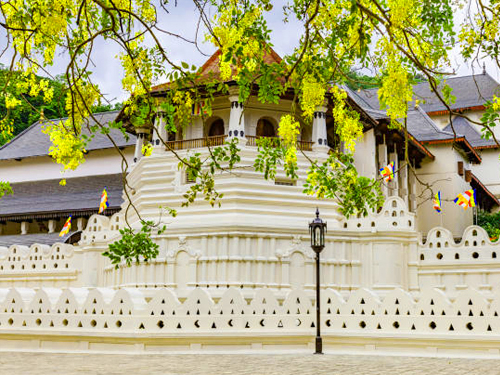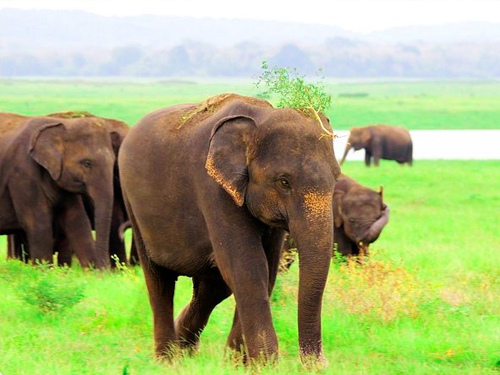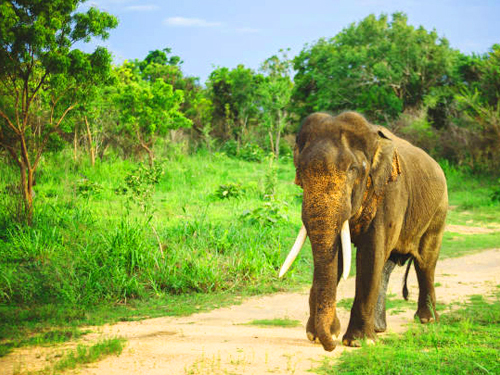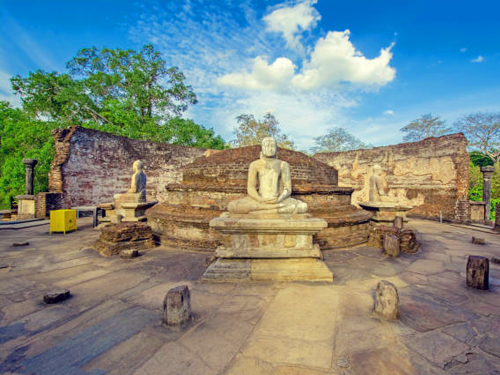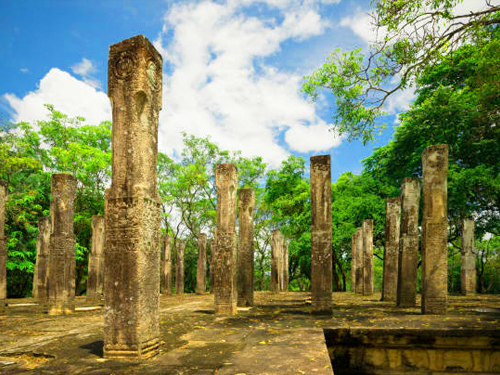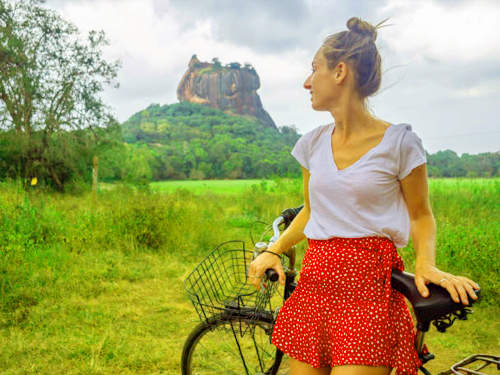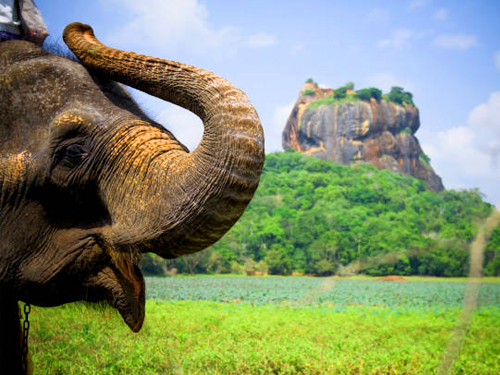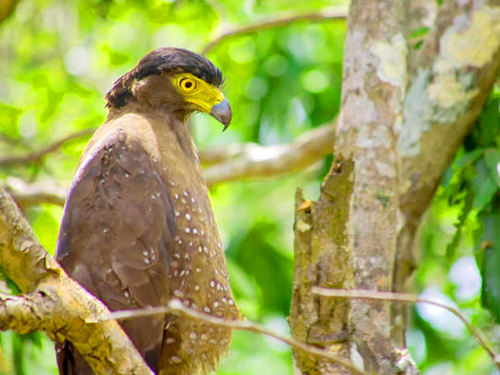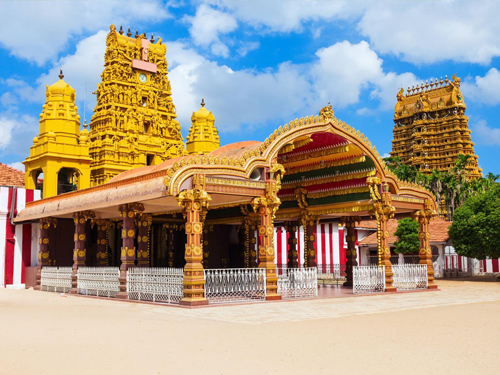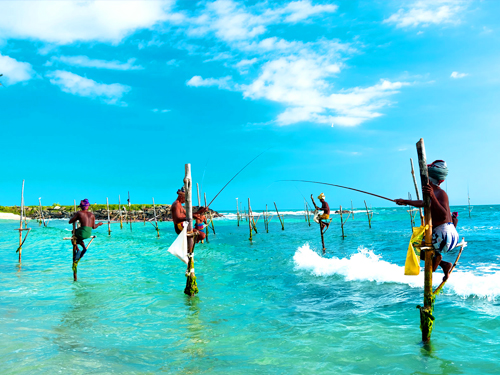Sigiriya in Sri Lanka
Sigiriya Lion Rock has architectural value
The architectural excellence of Sigiriya is exemplified by the complex of royal palaces on the rock summit, which was believed to have been the royal residence for King Kasyapa. Even though we only have the ruins today, these buildings clearly show the splendor of architecture in historical times. The Sigiriya complex is centered at the magnificent Sigiriya palace complex, which rises 200m above the surrounding plain. Built on an area of approximately one and a quarter hectares, the palace's buildings were built on a sloped terrain. It is the oldest and most well-preserved complex of palaces in Sri Lanka. The brick wall that surrounded the summit was built at the edge of the rock. It is believed that its footings are still visible today. The palace garden is made up of small ponds, terraces, and areas that are located on the eastern side of the summit. This area includes the outer palace area as well as the sloped terrain to the south.
Another structure that highlights the architectural merit of the rock summit's main entrance is the rock summit's main entrance. Sigiriya's massive lion paws are what gave the rock summit its name, Sinha-Giri meaning Lion rock. Sigiriya was later named after them. It is a stunning sight to see the staircase that has been constructed to climb the summit via the pair of lion's paws at the northern end. Even though one can see the remaining lion feet, it is believed that there was a huge brick lion at this location. The staircase then runs into the mouth of the lion.
The Sigiriya architects' architectural talents are also evident in the construction of the summer palaces within the pleasure gardens. The flattened islands located adjacent to the fountain garden are thought to be summer palaces that were used to relax and enjoy the leisure time of a king. The surrounding waterways and bridges that were made by cutting through the rock surface provided access to the area.
Sigiriya's History
According to literary sources, the Sigiriya royal palace complex has a long history that dates back to 5th Century AC when King Kasyapa built it. Based on archaeological evidence and research by many scholars, however, it seems that the area has been around for several periods during the prehistoric and historic periods.
According to excavations and investigations in the caves near the Sigiriya summit, and at the open-air sites surrounding it, the Mesolithic people were the first inhabitants of the Sigiriya area. Archaeologists discovered many archaeological remains that support the above information, including bone tools and stone tools as well as faunal and floral remains.
The historical period of Sigiriya began in the 3rd century BC. It was the time when Buddhist monks settled on the site and transformed it into a monastery settlement. This is evident by the rock caves with drip-ledges and the inscriptions found on the rock surfaces that date back to the 3rd – 1st centuries. Inscriptions indicate that the caves were granted to Buddhist monks to be used as residences.
Sigirya was modified as a fortified capital city under King Kasyapa's rule (477-495 AC). This is the landmark in Sigiriya's history, along with architectural buildings and paintings and hydraulic engineering. According to chronicles, the construction of Sigiriya as an elaborate palace complex was related to the country's political history in the second half of the 5th century AC. Kasypa was one the two sons from King Datusena, who ruled the country during the Anuradhapura period. Kasypa was the only son of a nonroyal consort. Mugalan, the other son Datusena's, was born to the queen and thus was the rightful heir of the throne. With the support of an army commander, Migara Prince Kasyapa took the kingship and murdered his father. Mugalan was also sent to India to help him fight against his brother. Kasyapa was unable to rule the country from Anuradhapura because he was afraid of Mugalan returning with an Indian army. To protect himself from any future attacks, Kasyapa chose to build his capital on a large rock that was surrounded by thick vegetation. This place became known as Sigiriya. According to the Culavamsa, King Kasyapa ruled for nearly 18 years in the country with comfort and wealth as well as tight security around the summit. He kept treasures safe and set up guards at various places to protect them. He built a magnificent palace there, worthy of admiration, and lived there as Kuvera (Geiger 1928, 39:3-6, pages. 42-43). According to researchers, Kasypan period could be considered the golden age of Sigiriya that made it a remarkable eye-catching wonder around the world. The Sigiri complex was once again inhabited after the defeat of Kasypa, Mugalan and the Indian army. Mugalan ruled his reign period from Anuradhapura. The royal structures were modified by Buddhist monks during the period post Kasypan, which lasted up to the 13th century. However, no damage was done to the beauty of the summit or the gardens.
Sigiriya Lion Rock Fortress, 5th century
Vessagiriya's 5thcentury inscription has given the temple the name "Kasabu Bo Upulvan Vehera". It depicts the names of Kasyapa and her two daughters. Vessagiriya is only half a km away from Ranmasu uyana, an architectural complex that blends nature with the built environment. It is therefore logical to accept the fact that Ranmasu uyana was a result of Kasyapa’s contributions to Sinhalese architecture and art. The tradition, which is the wisdom and knowledge of the past that has been passed down through generations, should inspire designers today.
6th, 10th Century Sigiriya Rock
You are probably aware that thousands of people have climbed sigiriya over the past thousand years to admire the palace buildings and paintings gallery. Sigiriya has been a site of historical, cultural, and natural interest since the 6th century. Social elites and art enthusiasts who had heard of the beauty and importance of the Sigiriya Royal Precincts, and the painting gallery, visited Sigiriya to experience the setting. They were inspired by the beautiful mirror wall and their poetic thoughts. Bell realized that the earliest examples of graffiti can be traced back to the sixth century. Bell also believed that most of the records belonged to the 10th century. Some statements made by Bells were incorrect because the evolution of Sinhalese script in 1905 was not fully understood. These graffiti were evidently the work of John Still, Bells' assistant, and Ayrton who succeeded Bell.
About King Kashayapa
Kasyapa was the child of King Dhatusena. Dhatusena, a young royal son, was originally a Buddhist priestess. However, he gave up the monk's saffron robes and took up arms in order to liberate his people from the twenty-eight years of foreign invasion.
Dhatusena began a relationship with a lower-caste woman during a 10 year grueling guerrilla war against the invaders. Kasyapa was born to them. Dhatusena, who was crowned king, left his lover of low caste and married a woman with royal blood.
Kasyapa, despite being the oldest son, was not considered an heir-apparent due to his low birth. His brother Moggallana was younger than him but was a descendant of the royal queen/wife.
Jonathan Forbes
According to records, Jonathan Forbes, a British army officer, was the first person to discover Sigiriya. Forbes and two friends rode horseback from Polonnaruwa to search for Sigiriya. They were the first to re-discover this lost citadel in the jungle, in 1831.
Forbes visited Sigiriya in 1833 in order to investigate its surroundings. He reported that plaster had been laid on the rock and was painted with bright colours. This was especially true in areas where the weather was not harsh. He did not describe the paintings.
Weather in Sigiriya
Sigiriya lies in the cultural triangle, which is part of the north-central Province of Sri Lanka. Sigiriya's annual rainfall was estimated to range from 1250mm to 2500mm per year. It is classified under the dry zone in Sri Lanka. Sigiriya's rainfall is significantly higher in April, October and November than it is in November, November, or December.
Importance of Sigiriya
In 1982, Sigiriya lion rocks was designated a UNESCO World Heritage Site. It is considered to be the island's most popular ancient monument. The status of UNESCO world Heritage Site was also granted to 2 other important ancient sites in Sri Lanka, Anuradhapura (Polonnaruwa) and Polonnaruwa (Polonnaruwa). These three sites were among the first to receive this distinction in Sri Lanka.
Sigiriya rock fortress could be described as another Hanging Bridge of Babylon. The Sigiriya rock fortress is very similar to the hanging bridge in Babylon. The Seven Wonders of the Ancient World are not the Seven Wonders of the Sigiriya Rock Fortress. Sigiriya is an engineering marvel that comes from ancient Sinhalese culture. The Sigiriya rock fortress consisted of several tiered gardens that included a variety of brick buildings, swimming pool, palaces, and other constructions. All of it was built on large monolithic rocks.
There are many evidence to support the existence of Sigiriya's rock fortress, which is not like the Hanging Bridge of Babylon. Its location, function, and importance can be proven by written archaeological evidence, such as chronicles and stone inscriptions. A large portion of the Sigiriya rock fortress can still be seen during the Cultural Triangle Tour of Sri Lanka.
The lower portion of the Sigiriya rock castle can best be described as one the oldest landscaped gardens anywhere in the world. It dates back to the 5th Century AD. It was once considered the 8th wonder of the universe.
Places to visit in Sigiriya
Sigiriya is one of the most impressive examples of ancient urban planning in Sri Lanka. The Sigiriya complex includes a royal citadel as well as an intricately planned city with ramparts and gateways. It dates back to the Kasyapan era. The palace's center is the huge Sigiriya rock. It is surrounded by two large cities zones, one inner-city (citadel), and one outer city. There is also a garden zone. The Sigiriya urban plan is enclosed by a double moat and triple towers that extend to the east and south.
Sigiriya's importance lies in its preservation of a perfect urban layout, as well as the planning technology of our forefathers. Sigiriya is a stunning combination of symmetry, asymmetry, and geometrical plan. It also incorporates natural surroundings. When looking westward from the gardens, the large rock summit of Sigiriya forms the backdrop. The area surrounding this summit is divided symmetrically by the east-west and north-south axes. They meet at the centre of the palace area at the top of the rock. The intricate planning displayed in the overall layout of Sigiriya demonstrates the genius engineering skills of our forefathers. Scholars know that the intricate symmetry of royal water gardens, moats and ramparts in the western precinct are based on an "echo plan". Bandaranayake says that Sigiriya's layout is remarkable because of its design mathematics and overall design. Sigiriya's total design is a stunning combination of symmetry/asymmetry, and of a deliberate interlocking a geometrical plan with a natural form.
The Western entrance leads to the Water Garden section of the Sigiriya complex. The area is roughly 12 acres in size and is best illustrated by its stark display of its attributes in a geometrically symmetrical spatial arrangement. This is the Miniature Water Garden, which is separated from the Water Garden by a wide barrier. The stunning view of the four L-shaped ponds is apparent as one enters the premises via the Western Entrance. You will also see the deep reservoirs-like structures that collect water, likely to be used in these four L-shaped ponds. Most likely, the Pleasure Pavilions are located between these ponds. This is where the King might have seen the water sports being performed in the ponds.
Three types of garden are found in the Sigiriya landscape: water gardens, terraced gardens, and boulder gardens. These gardens are distinctive in design and can be considered the oldest large-scale, surviving garden forms in Asia. These water gardens are the largest and most intricate, consisting of three main sections. The three main water garden units can be seen along the central east/west axis, and the miniature garden. The garden layout, which includes a series of interconnected water features, reflects the highly refined landscape design sensibility of Sigiriya's architect. For ease of identification, three main garden features are designated as "Garden No.1, No.2" and "Garden No.3". They are also called "Fourfold garden", fountain garden, and asymmetrical gardens.
Garden No.1 consists of a central island and four 'L-shaped' ponds. Based on evidence, it is believed that this island contained a large pavilion. There are a number of terraces around the island that allow easy access to the water. The area known for its special water features is called "Fountain garden", which is composed of two large ponds that are opposite each other. A shallow, broad, and flowing water can be seen on either side the fountain garden's upper precinct. These streams are often called 'Serpentine stream'. The four fountains are located at the end of the two shallow streams. Two on each side are formed by water escaping through holes that are symmetrically aligned and constructed from circular sandstone slabs. Garden No.3 includes a large, octagonal-shaped pool as well as an L-shaped pool. These main units are not the only ones that make up the Sigiriya water garden complex. A miniature water garden, with many ponds, pavilions, and summer palaces, has been indisputably identified to be the most beautiful and distinct component of the water garden arena.
The layout of the Boulder Garden at Sigirya is quite different from that of the water gardens. It has an asymmetrical design and was built in a different historical setting. The area is made up of many rocks and boulders. Nearly every boulder and rock has a pavilion, as shown by the markings on them. You can see rock shelters underneath many boulders. These shelters were inhabited by ancient Buddhist monks and then redesigned as a feature in the royal garden. These boulders allow one to walk along narrow paths that lead to the terraced garden.
The Sigiriya Terraced Garden can be seen in association with the natural hill that lies at the base Sigiriya rock. It was built with a series walls, some of which are now crumbled to mounds, and others are being restored. The terraces are finely arranged around the rocks, and some of them interact with the natural rocks that display cultural landscape features. Brick-built staircases with limestone steps are laid throughout the terraced garden. They connect the paths of the boulder garden to the main staircase that leads up to the rock.
At the highest point of the Terrace Garden, you will find the Mirror Wall. It can be reached by passing a series of steps. The Mirror Wall, with its polished surface, is an architectural wonder and a literary masterpiece. It is fascinating to see the facts about history, society, and economy that result from the emotions of Sigiriya damsels as well as the serenity of the environment translated into poetry and posted on the Mirror Wall at Sigiriya. Professor Senarath Paranavitana has published 685 of these graffiti poems.
The only way to the palace from the Lion's Paws Terrace is via the Lion King's Entrance. The Lion Staircase faces the North and has in front it the lion's feet made of brick and mortar. The colossal lion's head is visible only from the front paws. The pair of lion's feet, which are situated on a thin ornately shaped platform, is a scaled up model that resembles the real thing. The site's remnants and past information indicate that there was once a lion's head here in ancient times. The entrance was carved in the shape of a lion's Jaw, suggesting that Sihagira, the Rock, had existed in the past. This Rock evolved into the present Sigiriya.
The paintings of Sigiriya, located on the west side of the rock surface, have been a focus of special interest both in ancient and modern times. They display excellent artistic features from the 5th century. Some of these paintings can still be seen today, despite years of climate change. The Mirror Wall is an ancient graffiti that refers to approximately five hundred frescoes that covered a large area of western Sigiriya Rock. Two slides can be seen on the rock's surface today, showing small fragments of Apsaras-like female figures. The line of paintings would have extended across the rock's western surface, creating a stunning view for those who lived below the rock. It was a curtain of colorful paintings. The reflections of these paintings can be seen in the water ponds at the water garden in the ancient period.
The pathway leads to the rock summit from the other side of the painting belt, about halfway up the western side. A brick wall of two meters high protects the path's outer edge. The wall is covered with lime mortar and polished to an inner mirror. This creates special scenery. Due to its reflecting surface, this wall is called 'Katapath paura' or "mirror wall". Even after so many years, you can still see the shine of this wall today. From the 6th Century up to the 14th century, thousands of tourists visited Sigiriya. Inspired by the wonders they saw, many wrote poetry on the Mirror Wall. These poems are still in existence. These pieces are called Sigiri graffiti. There are more than 1800 pieces of prose and poetry as well as commentary from ancient tourists. These graffiti provide fascinating insights into the history and evolution of the language in Sigiriya over time. Scholars, including Prof. Paranavithana, have deciphered nearly 1500 writings.
It is situated at the top of the rock and has an area of approximately 1.5 hectares. It was the heart of the city's central area. The palace complex can be divided into three main sections: the lower palace, the upper palace, and the palace garden. Prof. Senaka Bandaranayake explains that the palace at the summit and the great Lion presided over the surrounding area, which was a strong expression of royal authority and control over the power-rich landscape of Sigiriya.
You can find a cobra-shaped rock at the Boulder Gardens' next level. This is also known as Cobra Hood Cave. You will be able to see the cobra-shaped hood of the rock if you raise your head. Ramayana's facts state that Sita was attracted to this rock. Its wall is covered in prehistoric drawings, which provide a link between Sita and the cave. These drawings are different to those on the Sigiriya walls.
The archaeological museum can also be found near the Sigiriya fortress. It is located in the vast area between the outer moat on the west side of Sigiriya and the middle rampart.
The archaeological museum displays a wide range of artifacts found at the site, including pottery, building materials, and small metal objects. For those who have difficulty getting up to the Sigiriya caves, the museum also displays copies of the Sigiriya frescoes.
The museum also contains guard stones and Torsos Buddha statues. The museum currently displays valuable artifacts such as a blue-glazed amphora, which is evidently of foreign origin, and an intricate lock that must have been part of a large door.
Sigiriya fortress, also known as Sigiriya castle, is home to many attractions, including the ruined palace and Sigiriya gardens, audience halls and fountains, as well beautiful paintings. The Sigiriya archaeological site dates back to the 5th Century AD. Bricks and stones were used in its construction.
Sigiriya Lion Rock is a place where you can find out about the sophisticated knowledge of ancient Sri Lankan engineers who created one of the most complex landscaped gardens in Asia.
Dambulla, which is about 15km from Dambulla, is the closest major town to Sigiriya. Travelers must travel 7km from Dambulla via Dambulla-Habarana's main road, before turning right onto the road that leads directly to the Sigiriya rockfortress. The travelers will need to travel an additional 8 km to reach Sigiriya after taking the turn to their right from Dambulla-Habarana's main road.
Sigiriya is one of the UNESCO world heritage sites on the island. It is under the control of the archaeology department. Entry to the Sigiriya archaeological site is 30$ per person.
Sigirya has many places and activities. It is worth the historical and educational importance it has. Below are 7 recommended places to see in Sigiriya during your Sigiriya tour.
- Pidurangala temple
- Sigiriya jungle
- Sigiriya museum
- Minneriya national park
- Sigiriya Eco-park or Hurulu eco-park Sigiriya Mirror wall
- Dambulla cave temple

 Safe Travels
Safe Travels Français
Français Deutsch
Deutsch עִברִית
עִברִית Italiano
Italiano Nederlands
Nederlands Polski
Polski Pусский
Pусский Español
Español
